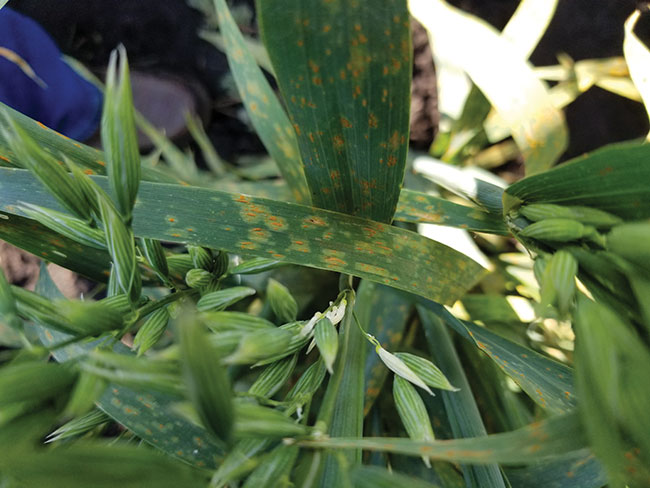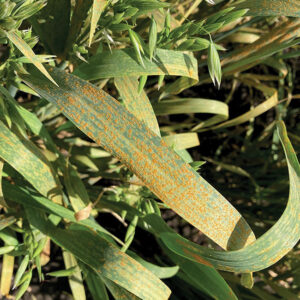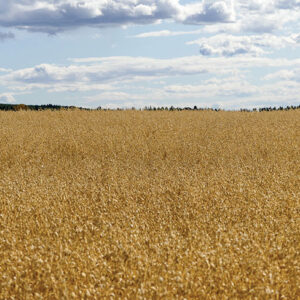
Features
Diseases
Crown rust in oats
This perennial disease needs dethroning.
April 29, 2024 By Bruce Barker
 Crown rust can cause up to 40 per cent yield loss, or more.
Photo courtesy of AAFC.
Crown rust can cause up to 40 per cent yield loss, or more.
Photo courtesy of AAFC.
Crown rust in oats is a royal pain. It’s a worldwide problem wherever oats grow, except in dry, arid areas. Crown rust, caused by Puccinia coronate var. avenae f. sp. avenae, is economically significant in Quebec, Ontario, Manitoba and eastern Saskatchewan.
“Crown rust is the most widespread and damaging disease of oat,” says Jim Menzies, a plant phytopathologist with Agriculture and Agri-Food Canada in Morden, Man. “Yield losses can range from 10 to 40 per cent or higher in severe epidemics, and it can cause losses in grain quality as well.”
In 2022, crown rust was at epidemic levels on the eastern Prairies, with 97 per cent of fields surveyed having the disease. The mean number of plants infected per field was 38 per cent, and the severity of infection was higher than what has been seen over the past 10 years. This was followed in 2023 with 90 per cent of fields surveyed having the disease, with an average of 45 per cent of the plants being infected and an infection severity slightly higher than what was observed in 2022.
“Some fields were severely infected and suffered yield losses in both years,” says Menzies.
Another severe year was 2020, with 86 per cent of fields infected, while 2018, 2019 and 2021 had minor disease pressure, likely caused by low precipitation in those three years.
The optimum conditions for crown rust development are warm sunny days of around 20 C to 25 C and mild nights with temperatures around 15 C to 20 C and adequate moisture for dew formation. The crown rust fungus can overwinter on stubble and grasses on the eastern Prairies, but can only infect buckthorn plants in the spring. On buckthorn, the fungus reproduces into a form that can infect nearby oat crops. But because buckthorn is not commonly found on the Prairies except for city parks, ravines and riverbanks, this source of infection is of minor concern.
The main source of crown rust infections on the Prairies is spores that blow up on southerly winds from the U.S. on the ‘Puccinia Pathway.’ The first inoculum usually arrives around late June or early July. During the growing season, agronomists and growers can follow the rust situation in the U.S. through the United States Department of Agriculture’s (USDA’s) Cereal Rust Bulletins.
Symptoms of crown rust on oat are orange pustules on the upper and lower leaf surfaces. Sheathes and glumes can also be infected under severe infestations.
The crown rust fungus is genetically very variable. Eastern and western Canadian populations are very different, but both are equally variable. Since 2002, approximately 2,500 isolates have been assessed for virulence – the ability of the pathogen to infect a host. In any given year, about 80 per cent of the isolates are unique races. Menzies says that only about two per cent of races are found repeating over a five-year period, and if a race is found at four per cent of the population, it is considered to be a dominant race.
Controlling the disease
The foundation of crown rust management is the use of resistant oat varieties. Provincial Seed Guides provide crown rust disease resistance ratings, however the genetic diversity of the fungus means that plant breeders must continually use new sources of resistance. For example, the oat varieties Stainless, Souris and AAC Justice relied on the Pc91 gene as a source of effective resistance, but virulence was first noted in 2012 at six per cent and had risen to 67 per cent by 2015, effectively overcoming the resistance.
Similarly, the Pc94 gene used in some varieties was effective and virulence remained low at around two per cent in 2015, but is now at 20 per cent. “Honestly, it could go up to 60 per cent next year. I don’t know. The pathogen is just that variable,” says Menzies.
The genetic diversity of the pathogen becomes an issue with variety ratings.
“A crown rust resistant gene remains viable as an effective gene for resistance, on average, less than five years,” he says.
Even though resistance genes may be overcome, Menzies says that growers should still grow a variety with a resistant or moderately resistant rating.
“Use resistant varieties. Go to the seed guide and if it gives it a good rating, I would use it anyway. Even if the pathogen population has changed, lines that had good resistance tend to do better than lines that never did have good resistance, even if the resistance is overcome,” says Menzies. “And to be fair, some of those lines do have good resistance. So it is kind of the luck of the draw. I’m sorry to say that, but those resistant ratings have been done and there is a lot of work behind those ratings.”
Menzies says another management strategy is to seed early. This will allow the oat crop to mature earlier and avoid inoculum buildup and disease development. As a result, the severity of the disease could be lower with the earlier seeded crop.
Another strategy is to select fields away from buckthorn infestations. As an alternative host for crown rust, sexual reproduction of crown rust and infection of oat will start earlier in the year than if the fungus is blown in from the U.S.
Foliar fungicide application is the last line of defence. Menzies recommends that oat fields are scouted in early July for signs of the disease. The ideal application timing is at flag leaf emergence. Once the flag leaf is infested with pustules, it is too late to apply a fungicide. Growers should consult with their oat buyer to ensure that a foliar fungicide application is acceptable to the end-use market.
Growers are also encouraged to consider the weather and the potential for disease development. Menzies says that if the weather is dry and little disease has developed by late July, fungicide application may not be warranted. He also recommends that growers rotate fungicide groups to help prevent the development of fungicide resistance.
“It is the same as the resistance gene,” says Menzies. “If you put a resistance gene out on a huge acreage, the pathogen will evolve to overcome that resistance. If you use the same fungicide over a large acreage, the pathogen will evolve to overcome that fungicide.”

